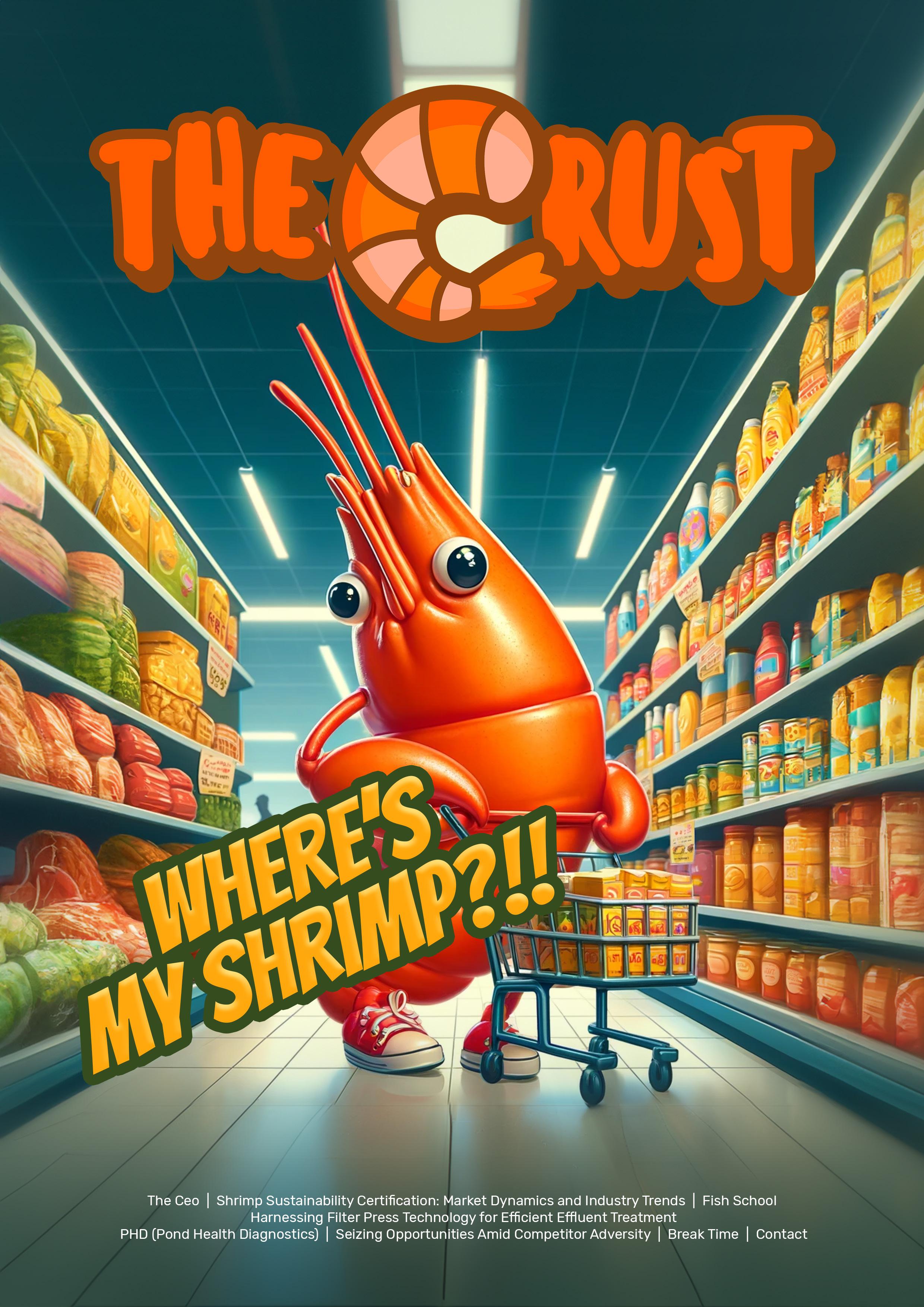


Greetings, esteemed readers, and welcome to this month’s edition of THE CRUST. As we delve into the latest happenings, allow me to shine a spotlight on a delightful celebration: United States National Shrimp Day. Now, how many of you were aware of this occasion? I must confess, it came as a pleasant surprise to me, prompted by the flurry of social media posts dedicated to our beloved crustaceans on May 10th. Nevertheless, I’m thrilled to see shrimp honored in such a manner in the U.S., and I believe it’s high time we celebrated this internationally.
Shrimp, despite being a cherished delicacy enjoyed by millions worldwide, has often been overlooked as a protein source. One significant barrier to its broader consumption has been its perceived luxury status, driven by historically high prices. However, there’s reason to believe that this narrative is evolving, as farm-level shrimp prices have witnessed a notable decline in recent years. With robust global production, fueled by innovative farming practices and technological advancements, it’s time to make this delectable commodity more accessible to a wider audience. Furthermore, producers are actively engaging consumers by diversifying their product offerings to cater to varied tastes and preferences. From succulent grilled shrimp to mouthwatering shrimp tacos, the culinary possibilities are endless.
Certifications have long been a point of contention between producers and importers, with the Best Aquaculture Practices (BAP) and Aquaculture Stewardship Council (ASC) certifications standing as prominent examples. While these certifications uphold important standards related to environmental sustainability, social responsibility, and food safety, their adoption presents challenges for small-scale farmers. The costs associated with certification, coupled with limited incentives and market access, create barriers to entry, particularly for farmers in developing regions. We advocate for the establishment of
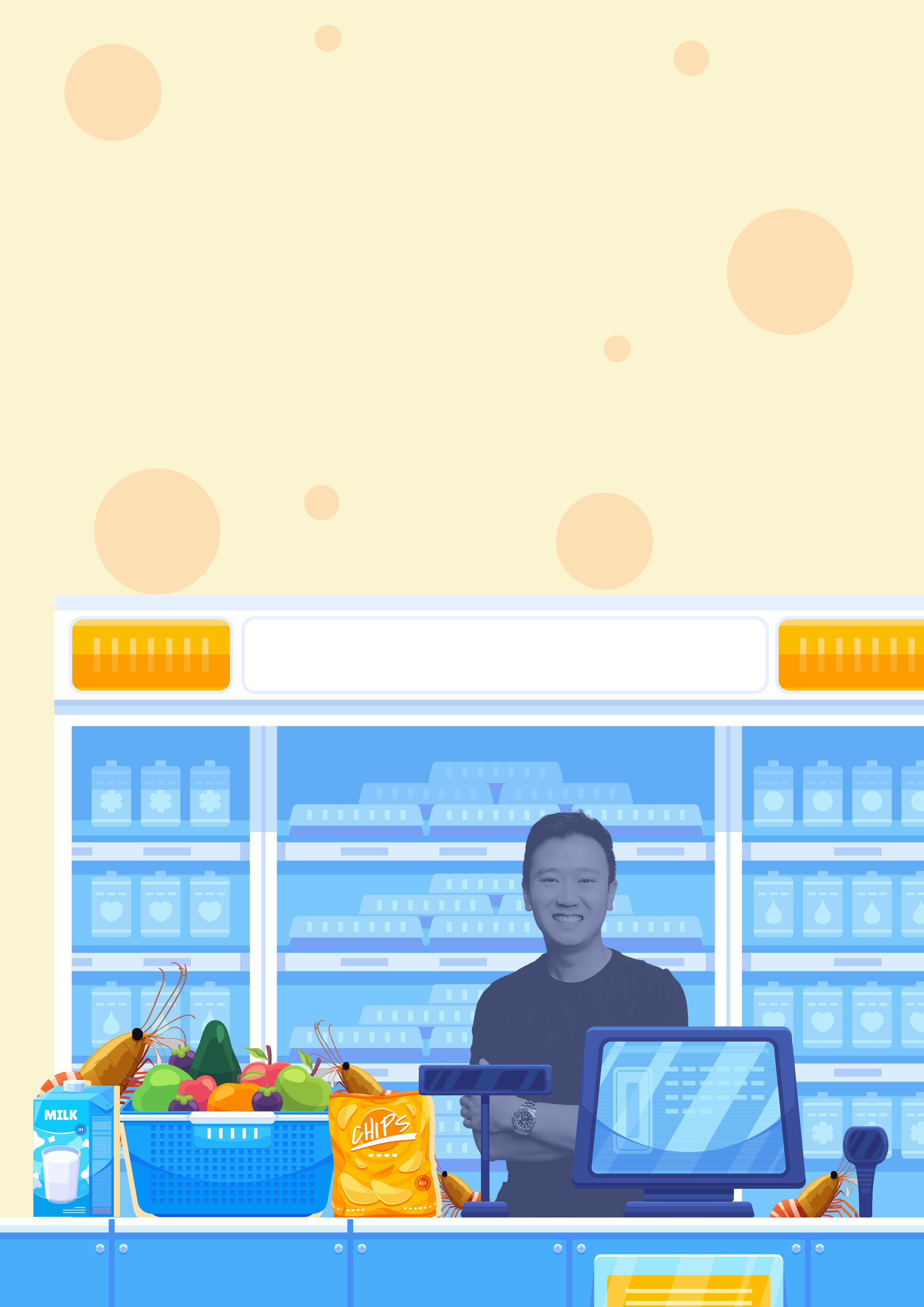

Thea middle ground that enables farmers to meet these standards while ensuring consumers access quality shrimp products that adhere to rigorous ethical and environmental standards.
Lastly, I’m delighted to announce our upcoming flagship event, the Shrimp Aquaculture Conference, set to take place next month in the serene surroundings of Bali. For those unfamiliar with this event, I encourage you to explore our website and social media platforms to discover our mission and objectives. Our conference serves as a dynamic platform for industry stakeholders to exchange ideas, share best practices, and collaborate on solutions to pressing challenges facing the shrimp aquaculture sector. To our esteemed attendees who have already registered, we eagerly anticipate your presence and look forward to welcoming you soon!
THE CRUST - RIZKY
CEO
CHIEF EDITOR OVERVIEW
Rizky Darmawan Chief Editor
Photo source : doc. The CRUST
Issue 20 | May -2024 2
As sustainability gains traction, consumers in major seafood-importing countries like Europe, North America, and Japan are increasingly interested in understanding the sustainability of the aquaculture products they purchase, including shrimp species. To meet this demand, sustainability certification and labeling have emerged as effective tools to provide consumers with relevant information.
Sophia Balod, the Global Press and PR Manager for a prominent certification program called ASC (Aquaculture Stewardship Council), tells The Crust that in 2023, France emerged as the leading market for ASC-labeled Pacific white shrimp, with consumers having access to 20,118 metric tons (MT). Following closely behind, Germany declared the second highest volume of ASC-labeled products at 16,055 MT, with the Netherlands trailing at 6,261 MT. Additionally, Switzerland stood out as the primary market for ASC-labeled black tiger prawn in 2023, with 1,360 tonnes, followed by France with 746 tonnes, and Belgium with 338 tonnes. Meanwhile, demand for this certification is
also steadily rising in seafood destination countries like the United States and Japan.
On the producer side, Sophia says there has been a significant surge in ASC certification adoption among shrimp farms in recent years, showing consistent annual growth since the introduction of the ASC Shrimp Standard in 2014. In 2023, the total number of certified shrimp sites reached 668, marking a remarkable 106% increase from just four years earlier (324 ASC-certified sites in 2019).
The top three countries with the highest number of ASC-certified shrimp sites in 2023 are Vietnam (305), followed by India (153), and Ecuador (82), collectively delivering nearly half a million tonnes of responsibly farmed shrimp. Moreover, as of April 2024, an additional nine farms in Indonesia have attained ASC certification.
Ensuring Environmental and Social Sustainability
Roy van Daatselaar, ASC Improver Programme Head, explains that ASC’s mission is to transform aquaculture towards environmental sustainability and social responsibility by using efficient market


Shrimp Sustainability Market Dynamics and
mechanisms that create value throughout the supply chain.
The ASC’s Theory of Change aims to provide recognition, trust, and rewards, creating value from farm to fork for both farmers and consumers.
This value can manifest in various ways, including access to markets (like selling to ASC-committed retailers), creating a framework for obtaining a social license to operate, fostering community engagement for farmers, promoting more efficient farming practices, and encouraging sustainable purchasing behavior among consumers. Additionally, ASC collaborates with seafood-consuming countries that prioritize sustainability. These countries offer incentives to producers who follow responsible production practices.
“We are confident that farmers, the seafood supply chain, and retailers value what the demanding ASC cer-
tification offers, but we cannot and do not promise so-called ‘price premiums’,” says Roy.
ASC certification is available for farms and feed mills. While the standard includes requirements for sourcing post larvae (PL), there is currently no separate standard specifically for hatcheries. However, companies further down the supply chain, such as processors, must acquire Chain of Custody (CoC) certification if they wish to buy and sell ASC-certified shrimp.
According to Sophia, The ASC farm certificate is issued by an independent certification assessment body and remains valid for three years. Farms are subject to annual onsite surveillance audits to ensure that their daily activities align with the ASC Standard. Moreover, unannounced audits may occur at any time to further verify compliance.
“The cost of certification is set by the independent third-party conformity assessment bodies, and ASC receives no money from the certification process,” says Sophia.
Challenges and Trade-offs
While global certifications like ASC are well-intentioned, their adoption in Indonesia remains uncommon. Denny Leonardo, a young shrimp farmer from Jakarta, reveals some reasons for this.
ARTICLE
Denny Leonardo
Roy van Daatselaar
Issue 20 | May -2024 3
Sustainability Certification: and Industry Trends

He notes that many farmers do not see the urgency of certification because their target market countries do not demand it, regardless of whether they actually implement sustainable principles in practice. This is compounded by the potential for additional costs, especially for smallscale farmers. Moreover, these added expenses do not translate into increased selling value, as buyers have yet to view certification as a significant factor in product value.
Roy van Daatselaar understands the complexity of the shrimp industry, which is highly fragmented and comprises hundreds of thousands of small or family-owned businesses. He acknowledges that smaller farmers face challenges in obtaining certification due to their limited financial and technical capacities to meet the certification requirements. The audit cost for smallholder shrimp producers would be relatively higher compared to vertically integrated commercial shrimp farms.
However, Roy emphasizes that they are committed to supporting small-scale farms in implementing sustainable principles and certification. He says ASC offers two programs; The Group Certification and Improver Programme. The Group Cer-
tification is a farmers group certification program that aligns standard processes according to demand and distributes the administrative burden of certification among the members. On the other hand, The Improver Programme provides smallholder shrimp farmers, or those in need of additional support to make improvements, with the opportunity to participate in an Aquaculture Improvement Project (AIP), with a more structured timeline and process.
Sophia adds, “We have seen a number of cooperatives become ASC certified through the group process, including four producer groups: the PT Central Proteina Prima Farm group in Indonesia, with 560 Pacific white shrimp farms; Minh Phu Mangroves Shrimp Social Enterprise in Vietnam, a group of 450 giant tiger prawn farms.” The other examples include the Jusanhama Gyokyo Youth Association and the Azuma-cho Fisheries Cooperative Association in Japan, each comprising nineteen seaweed farms producing kelp and wakame, and seven Japanese amberjack farms.
Preparing for Future Market Demands
Even though global certification may not be immediately
necessary in certain shrimp market countries, adhering to the principles of certification is beneficial for farmers to adopt. This is particularly important when it comes to maintaining accurate financial records and promoting environmental sustainability.
The growing concern about climate change may compel the shrimp industry to decrease its carbon footprint in the future, often a component of certification assessments. Denny forecasts that within a decade, global consumers will become more conscious of this issue, prompting shrimp producers to embrace sustainability principles. Consequently, buyers or intermediaries will seek raw shrimp materials that align with their consumer expectations.
“So, we take frameworks like ASC or BAP (Best Aquaculture Practices), gather the data, and integrate it into our pond practices. This ensures we’re aligned with their standards. For instance, we adopt their reporting format in accounting, preparing for potential collaboration with
Sophia Balod
intermediaries bridging buyers and producers. Then, in the future, if there’s a middleman who can bridge the gap between the buyer and producer, and if we have a middleman who has a system ready to bridge outside certification, we are prepared,” Denny concludes.

ASC-certified shrimp products
Photo source : doc. Sophia Balod, ASC, The CRUST
CRUST - AB Issue 20 | May -2024 4
THE
fish School
TAN, or Total Ammonia Nitrogen, stands as a pivotal parameter in water quality assessment, particularly in aquaculture and wastewater treatment. It encompasses both the ionized (NH4+) and unionized (NH3) forms of ammonia in water. The equilibrium between these forms is pH-dependent, with higher pH levels favoring the toxic unionized ammonia. In aquaculture settings, ponds typically maintain a pH below 9, mitigating the risk of NH3
To effectively manage TAN levels, farmers can implement several strategies:
1. Probiotics: Promoting a robust population of nitrifying bacteria is essential for facilitating the nitrification process. This can be achieved by supplementing the pond with materials beneficial to bacterial growth or introducing bacteria strains known to enhance nitrification, such as Nitrosomonas and Nitrobacter.
2. Aeration: Adequate oxygen supply is imperative for nitrification, as it is an oxygen-dependent process. Maintaining dissolved oxygen (DO) levels above 4.0 ppm ensures the uninterrupted progression of nitrification.
3. Water Exchange: In instances where TAN levels remain elevated despite other interventions, excessive nutrient buildup within the pond may be the culprit. Diluting pond water through water exchange can help alleviate this issue, albeit temporarily.
4. Harvest: Persistent, uncontrollable increases in TAN levels may signal that the pond has reached or exceeded its carrying capacity. In such cases, partial or full harvest of the stock may be necessary to prevent further deterioration of water quality and mitigate potential harm to aquatic life.
toxicity. However, vigilance remains crucial. Despite its largely innocuous nature, farmers must diligently monitor TAN levels to prevent sudden spikes that could disrupt pond ecosystems. NH3 concentrations exceeding 0.2 mg/L can pose health risks to shrimp. Farmers can employ NH4+ and NH3 test strips, readily available in stores. Elevated TAN levels may indicate an imbalance in the pond’s bacterial population, requiring intervention.

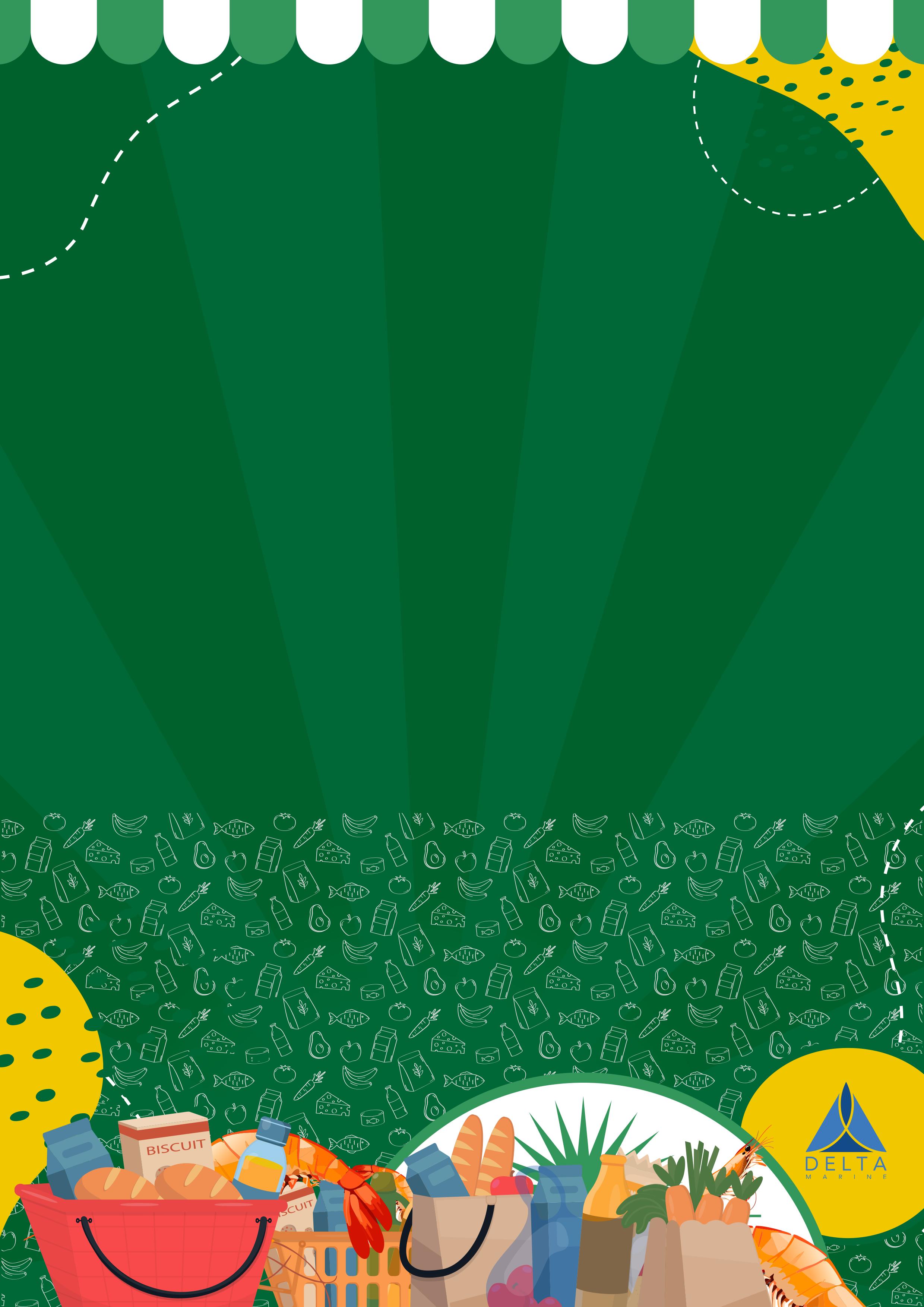

TAN Chemistry Class
Issue 20 | May -2024 5 Photo source : doc. Delta Marine Indonesia
THE CRUST - DELTA MARINE INDONESIA
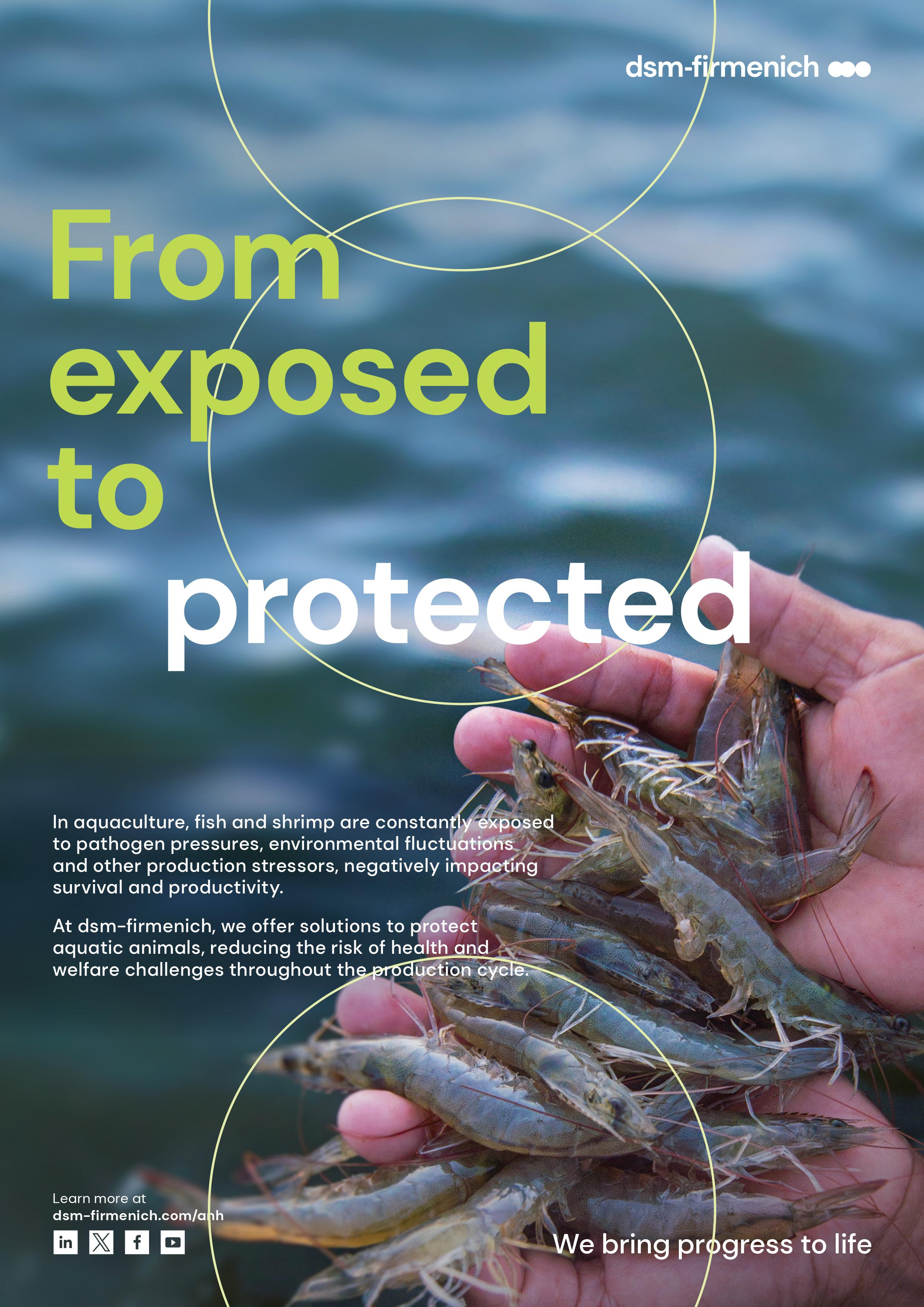
Harnessing Filter Press Technology for Efficient Effluent Treatment
Shrimp ponds inevitably generate organic waste as part of their production process. It is crucial to properly manage this waste to prevent pollution when it is released into the environment. Pollution not only harms the surrounding ecosystem but can also negatively affect the pond itself.
Some methods have been developed to overcome the waste in shrimp farming, which is dominated by sludge. Guillermo A. Corona Herrera, President of Reef Aquaculture Conservancy, explains that untreated shrimp farm effluent contains high levels of organic matter, nutrients (like nitrogen and phosphorus), and potentially hazardous chemicals. If this effluent is released directly into natural water bodies, it can cause significant environmental pollution.
He adds that this pollution can lead to eutrophication, causing algal blooms that deplete oxygen levels in the water. This harms aquatic life and disrupts local coastal ecosystems. “Additionally,” he tells The Crust, “untreated effluent may harbor pathogens and diseases that can spread to wild shrimp populations and other marine species, posing a threat to biodiversity and the overall health of aquatic ecosystems.”
He also emphasizes that proper effluent treatment helps shrimp farms comply with environmental regulations and avoid potential fines while enhancing their reputation as sustainable and responsible producers. “Treating shrimp farm effluent is indispensable for safeguarding the blue carbon ecosystems and coral reefs, ensuring the sustainability of aquaculture operations, and supporting the long-term viability of the shrimp farming industry,” he explains.
How Filter Press Works?
Supratikno, Commissioner of PT. Bio Pilar Utama, suggests using the filter press method, which has never been used before in aquaculture, to process sludge from shrimp farms. This method is actually ideal for solid waste, not for dissolved liquids that cannot be pressed, as the filter press machine’s purpose is to separate solid waste from water. This process, known as dewatering, removes water content from the waste solids, resulting in a sludge cake or solid sludge.
The filter press has proven suitable for many industries, including food, textiles, and paper, and is now starting to be used in the mining industry. “It’s rarely used in shrimp farms, but it’s very possible and promising to use this machine for dewatering solid waste from aquaculture,” he says.
Supratikno explains that the filter press has a simple workflow. The main process involves filtering and then pressurizing the mud, a procedure known as dewatering. The solids are pumped into the filter


ARTICLE
Issue 20 | May -2024 7 Filter Press Machine Filter Press Machine
Fred puckle Hobbs
press machine under pressure, causing the water content in the mud to be expelled through the pores of the filter plates.
Fred Puckle Hobbs, Co-Founder of Tathva, sees the filter press method as a worthwhile solution for shrimp farmers. After observing its application at one shrimp pond, he noted a significant challenge: the sludge decomposes over time in the outlet canals, becoming sticky and harder to collect. Regular excavation is required When this happens, which is costly and time-consuming.
However, Fred believes that the filter press captures more than 40-50% of the organic matter, significantly reducing the Total Organic Matter (TOM) in the sea near the farm. “Reducing sea TOM means lower farm input TOM, which improves carrying capacity, leading to higher yields and extended farm life. It also benefits the surrounding ecosystem by lowering the anthropogenic impact on the environment, potentially supporting biodiversity. Additionally, the sludge cake produced could potentially be used as a biofertilizer, offering carbon abatement benefits, though this requires further proof,” Fred explains.
Long-term Investment
Pratikno acknowledges that a filter press may not be suitable for small-scale farms due to its high capital expenditure (capex). However, it is a valuable long-term investment for intensive shrimp farmers with high stocking densities. Despite the significant initial cost, the low maintenance costs and efficient land use make it worthwhile. The filter press only requires a small area of 3x5 meters and has a capacity of up
to 500 liters per cycle
This method ultimately ultimately enhances environmental safety and supports sustainable farming.
In addition, Fred

tells The Crust that, based on his observation, shrimp farmers need approximately USD25,000 to install a filter press machine capable of processing sludge from a 2.5-hectare pond, with a lifespan of ten years. He also believes that this investment can be recouped within three years, provided the farm is well-managed.
Overall, Fred claims that this technology is relatively simple and inexpensive with longterm benefits. It can be implemented in any region, as it functions similarly across various shrimp farming setups. While the initial focus would be on the Indonesian industry, the potential impact in Vietnam, especially on the Mekong River, could be significant. Further expansion to other territories like Thailand is also possible.
Expanding Fund Opportunities
Guillermo says by implementing the filter press treatment, farmers can improve operational efficiency, ensure compliance with regulations, access new market opportunities, and mitigate the risks. These improvements can enhance their creditworthiness and lead to more favorable financing.
However, both Guillermo and Fred agree that simply treating the water or sludge doesn’t automatically make farmers eligible for financing. Each credit or loan program has its own specific requirements. Fred emphasizes that credit is important because it offers a practical and predictable means of financing, supporting the sustainable growth and operational control of shrimp farming businesses. “Access to credit facilitates the adoption of new technologies and improvements, driving both economic and environmental benefits,” he adds.
THE CRUST - hk, ab
 Dr. Guillermo A. Corona Herrera
Supratikno
Photo source : doc. The CRUST, Supratikno,
Dr. Guillermo A. Corona Herrera
Supratikno
Photo source : doc. The CRUST, Supratikno,
Issue 20 | May -2024 8
Dr. Guillermo A. Corona Herrera
Sludge cake produced from the filter press process

First Anniversary of CeKolam: Serving Over 6,000 Shrimp Farm Samples in Indonesia
More than a year has passed since Nusantics made its mark in the shrimp industry, and it has been an exceptional journey. Initially a startup in the healthcare sector, Nusantics helped Indonesians access affordable Covid-19 tests when imported kits were scarce. Their journey in precision diagnostics began with the widely known mBioCov Covid-19 PCR test kit.
Nusantics, recognized with a prestigious award from the Illumina Accelerator, has since assisted over 450 shrimp farmers and hatcheries across Indonesia through CeKolam. CeKolam, an independent laboratory established by Nusantics, provides shrimp farmers and hatcheries with convenient access to high-quality lab services. These services offer greater accuracy, fast results, and cost-effective solutions.
“We want to provide a simple solution needed by shrimp farmers through the innovation of a disease detection kit, ShrimProtect, and the diagnostic service, CeKolam, which is fast, affordable, and highly accurate and sensitive,” said Revata Utama, CEO of Nusantics, at the first anniversary event some time ago.
During CeKolam’s one-year journey, one of the most intriguing findings was that disease distribution varies across regions. For instance, while one area may experience a high incidence of AHPND, this doesn’t necessarily reflect the situation in other areas.
These facts underscore that each farmer needs to conduct independent disease monitoring because disease distribution varies by location, necessitating different treatments. In her closing remarks, Sidrotun Naim, Advisor to CeKolam, thanked the Nusantics team for their recent advancements. She expressed hope that Nusantics’ goal of becoming ‘the security guard of Indonesian shrimp’ could continue to progress and develop under the



guidance of young Indonesians.
Ujang Komarudin AK., the Director of Feed and Fish Medicine at the Ministry of Marine Affairs and Fisheries (KKP) welcomed Nusantics and CeKolam’s contributions. “We warmly embrace the presence of CeKolam, and we should take pride in the efforts of our nation’s young generation, particularly Nusantics. Out of the 36 diagnostic kits registered at KKP, five of them are from Nusantics: namely WSSV, AHPND, IMNV, EHP, and TSV,” he remarked.
Meanwhile, Rubi Haliman from PT Central Proteina Prima Tbk provided an overview of strategies to combat disease from upstream to downstream. “We can take several actions to address diseases, starting with using SPF (Specific Pathogen Free) seeds. Then, implement good and proper cultivation procedures. Finally, support farmers by consistently monitoring disease and water quality through the efforts of the lab and quality teams,” he explained.
Additionally, Nusantics’ Research and Development (R&D) team shared their passion for developing shrimp disease detection kits and expressed gratitude for contributing to changes in farming practices. These changes enable more accurate disease management through the use of fast, precise, and cost-effective PCR-checked data.
To wrap up CeKolam’s first anniversary, Nusantics awarded the titles of ‘Vigilant Farmer’ and ‘Vigilant Hatchery’ to recognize their dedication to implementing disease monitoring practices throughout the production and farming process. This demonstrates that the aspiration to increase national productivity and global food stability can be realized through collaborative efforts. CeKolam aims to serve as the guardian of Indonesian shrimp, defending against disease outbreaks and fostering a vigilant ecosystem for healthy shrimp harvests.
THE CRUST - CEKOLAM

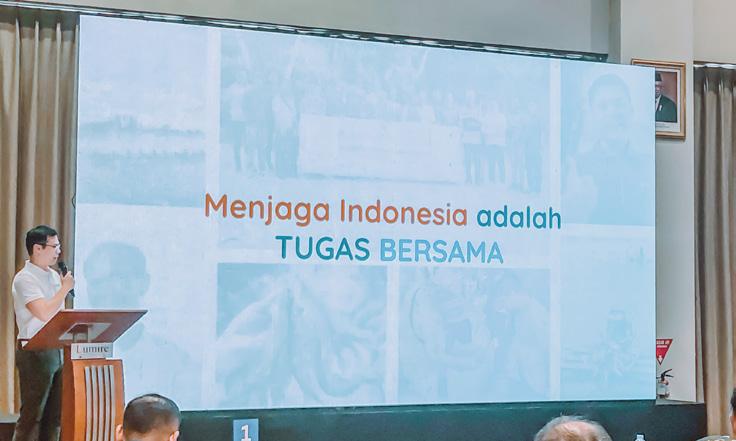
PHD Pond Health Diagnostics Issue 20 | May -2024 9
Unique Disease Cases Shrimp Talkshow at 1st Anniversary CeKolam CEO of Nusantics, Revata Utama, presenting CeKolam


Seizing Opportunities Amid Competitor Adversity
The US Department of Commerce is advancing cases of Countervailing Duty (CVD) and Anti-Dumping (AD) against several shrimp-producing countries, including Indonesia. Initial findings show Indonesia’s CVD is de minimis, indicating minimal impact. However, Indonesia faces a significant AD fine rate of 6.3%. According to Coco Cocarkin, the Secretary General of the Indonesian Shrimp Forum (FUI), this penalty does not consider that higher local prices in Indonesia may be due to longer cold chains and a limited local consumer base, rather than dumping practices.
Ecuador, on the other hand, faces even higher fines with a 10.58% AD rate and up to 13.41% for CVD. This means Ecuador might need to raise its prices to the US to offset these penalties. If Ecuador and other major shrimp-producing countries increase their prices, it would likely lead to a global price rise, as almost all major US suppliers are impacted by this issue.
Despite the two mentioned issues, The trend of rising shrimp prices is evident, though not as strong as in 2022. “Currently, the farm gate price of small Indonesian shrimp has increased by IDR 8,000-10,000 per kilogram. Despite this increase, Indonesian shrimp prices are still not the highest among world producers. Vietnamese shrimp are priced similarly to Indonesian shrimp, but the smallest sizes (size 100) have a slightly higher price,” says Coco.
Gerry Gilang, a young shrimp farmer
from Padang, West Sumatra, shares similar sentiments, noting a trend of rising shrimp prices. Although not very significant, the prices have been quite decent since late last year, with an increase of around IDR5,000/kg, especially for larger sizes. He also points out that the preliminary findings of CVD in Ecuador and Indonesia are still provisional, and not conclusive. Therefore, caution is advised as the percentage may vary.
However, he finds it surprising that the penalties imposed on Ecuador are not likely to affect the price of Ecuadorian shrimp significantly. He heard that Ecuador might be unable to contest the CVD and AD penalties, so they are creating a Free Trade Agreement (FTA) with China to export their shrimp there. He believes this move could pose challenges for other countries, including Indonesia, to enter the Chinese market, which he sees as a potential future destination for Indonesian shrimp.
Ecuador’s Subsidy Cut: An Opportunity?
Amidst the looming shadow of AD and CVD tariffs, Ecuadorian farmers are facing tough times due to the loss of diesel subsidies. However, Gerry doubts this will necessarily make Indonesian shrimp prices more competitive. Instead, Ecuadorian farmers are likely to simply cut their profit margins rather than increase prices. In addition, he mentions that the Ecuadorian government has provided assistance amounting to IDR 3 trillion through a local bank as a subsidy diversion, aimed at developing electrical infrastructure specifically for shrimp farms. This energy source could potentially be more efficient for farmers compared to using diesel.
In addition, Gerry says the removal of subsidies in Ecuador won’t have an immediate effect. But if the subsidies remain removed and no other assistance is provided, businesses may eventually find the industry less attractive and shift their focus elsewhere. This scenario might present an opportunity for Indonesian farmers to enhance their competitiveness, though this shift might take 5 to 10 years.
Gerry also highlights that shrimp prices are still influenced by supply and demand.

ARTICLE
Photo source : doc. PMI, Coco Kokarkin Issue 20 | May -2024 11
Gerry Gilang
While Ecuador’s subsidies were removed in 2023, the farm gate prices remained low throughout the year due to decreased demand from the US. Thus, the impact of Ecuador’s subsidy removal is overshadowed by the drop in demand.
Coco agrees that removing diesel subsidies for electricity won’t significantly affect their production costs as they use it efficiently. However, the removal of tax breaks, which have been very beneficial for farmers, might be quite burdensome, following the issue of the Ecuadorian government’s plan to implement an upfront tax of 3 percent on revenue. Additionally, moving the export port from nearby Guayaquil to a farther location will increase container rental costs by almost USD 500 per unit.
Leveling-Up Competitiveness Strategies
Targeting competitiveness by expecting other countries to incur higher cost of good sold (COGS) is not a prudent approach. Instead, farmers should prioritize efficiency to reduce their own production costs. Gerry recommends that farmers mitigate high mortality rates by adjusting stocking density according to their capabilities, the pond’s carrying capacity, and the pond’s infrastructure and construction.
Ecuadorian farmers achieve cost-effective production by employing lower stocking densities, which obviates the need for aerators and decreases energy consumption and other production inputs. He suggests that Indonesian farmers can boost their competitiveness by adopting similar strategies. However, it may be challenging to educate farmers about the advantages of low-stocking density strategies.
Gerry explains “We must keep in mind that COGS and FCR will remain low if we manage mortality rates and increase yield. It’s essential to prioritize keeping mortality rates low, using whatever methods are necessary. Focus on refining cultivation techniques and maintaining a high Survival Rate by either reducing stocking density or selecting genetics suited to our cultivation area. Eastern Indonesia typically favors fast-growing lines, while Western Indonesia leans towards resistant ones, enabling us to minimize the COGS. With low COGS, we’ll be better equipped to handle price fluctuations. Hence, during price changes, we can simply adjust our margins without suffering losses.”
According to Coco, aside from utilizing low stocking density or efficient technology, some countries achieve low COGS due to their efficient business chains, particu-
larly the integration of feed mills, broodstock centers, processors, and export ports. This integration hasn’t yet been well implemented in Indonesia, resulting in relatively high average COGS, reaching IDR 42,500/kg. Sometimes, the high COGS is worsened by the low SR, resulting in decreased annual productivity.
“However, if our SR is excellent and we implement a three-phase system with lower density, production will remain steady or increase by 30 - 50% annually with lower Production Costs,” Coco suggests.
In addition to reducing COGS, having a diverse market can also improve price stability, including targeting the local market. Gerry mentions China’s success in utilizing its local market because they have successfully built a culture of consuming shrimp for generations. It’s an effort that Indonesia can emulate.
Meanwhile, Coco emphasizes the importance of enhancing branding and promotion through storytelling about the real quality of shrimp. “For example, if our shrimp are more environmentally friendly, they should be frozen as soon as possible. A somewhat controversial approach could be, why not invite ASPA (American Shrimp Processors Association) and those vocal third parties certification to join Indonesian shrimp farming or cold storage companies?” he concludes.
THE CRUST - UTE, AB

Coco Kokarkin

Issue 20 | May -2024 12
Whats Your Shrimp? Break Time
Next time you’re strolling through your local supermarket’s seafood aisle, take a moment to notice the variety of shrimp available. These small, delicious crustaceans come in several species, each offering unique flavors and textures. Among the most popular are Whiteleg Shrimp, Black Tiger Shrimp, Blue Shrimp, and Freshwater Prawns. Let’s dive into what makes each of these species special and how they can be used in your culinary creations.

Whiteleg Shrimp
Scientific Name: Litopenaeus vannamei
Description:
Vannamei, also known as whiteleg shrimp, is one of the most commonly farmed and consumed shrimp species globally. Originating from the Pacific coast of Central and South America, these shrimps are characterized by their light gray to white color when raw, turning pink upon cooking.
Farming and Availability:
Vannamei shrimp are farmed extensively in South America, South East Asia, China, and India due to their fast growth rate and adaptability to different farming conditions. They are available yearround, making them a staple in many cuisines.
Culinary Uses:
Whiteleg shrimp are favored for their sweet, mild flavor and firm texture, making them suitable for grilling, boiling, and stirfrying. They are commonly used in dishes like shrimp cocktails, ceviche, and various Asian stirfries.
Blue Shrimp
Scientific Name: Penaeus stylirostris
Description:
Stylirostris, commonly known as Blue Shrimp due to the blue tint of their shells, are less common but highly regarded for their sweet, succulent meat. They are primarily found in the Pacific Ocean along the coast of Central and South America.
Farming and Availability:
While not as widely farmed as Vannamei or Monodon, Blue Shrimp are cultivated in countries like Mexico and French’s New Caledonia. Their seasonal availability can make them a special treat when in season.
Culinary Uses:
Blue Shrimp are versatile and can be prepared in various ways, including grilling, boiling, and sautéing. Their sweet flavor is perfect for shrimp salads, tacos, and seafood stews.
Black Tiger Shrimp
Scientific Name: Penaeus monodon
Description:
Black Tiger Shrimp, named for the characteristic dark stripes on their shells, are larger and more visually striking than other shrimp species. Native to the Indo-Pacific region, they are prized for their robust flavor and impressive size.
Farming and Availability:
Primarily farmed in Southeast Asian countries like Vietnam, Thailand, and Indonesia, Monodon shrimp are available throughout the year, though they tend to be more expensive due to their size and flavor profile.
Culinary Uses:
Their larger size and meaty texture make Black Tiger Shrimp ideal for grilling and barbecuing. They are also used in upscale dishes like shrimp scampi, pasta, and gourmet salads.
Freshwater Prawns
Scientific Name: Macrobrachium rosenbergii
Description:
Freshwater prawns, belonging to the Macrobrachium genus, are distinguished by their long, slender claws and larger size compared to marine shrimp. Native to South and Southeast Asia, they are known for their mild, delicate flavor.
Farming and Availability:
These prawns are cultivated in freshwater ponds and rivers in countries like Thailand, Bangladesh, and India. They are typically available during specific seasons depending on the farming cycle.
Culinary Uses:
The mild flavor and tender meat of freshwater prawns make them ideal for a variety of dishes, including curries, kebabs, and soups. They are also excellent when grilled or roasted.

While the shrimps mentioned above are among the most popular and widely consumed, the market offers many other shrimp species, each with its own unique taste and culinary uses. Exploring these varieties can add new dimensions to your seafood dishes. How many different shrimp species have you tried?
Issue 20 | May -2024 13
THE CRUST - RIZKY
Photo source : James Tiono, Del Pasifico Seafoods, Global Seafood, Manettas



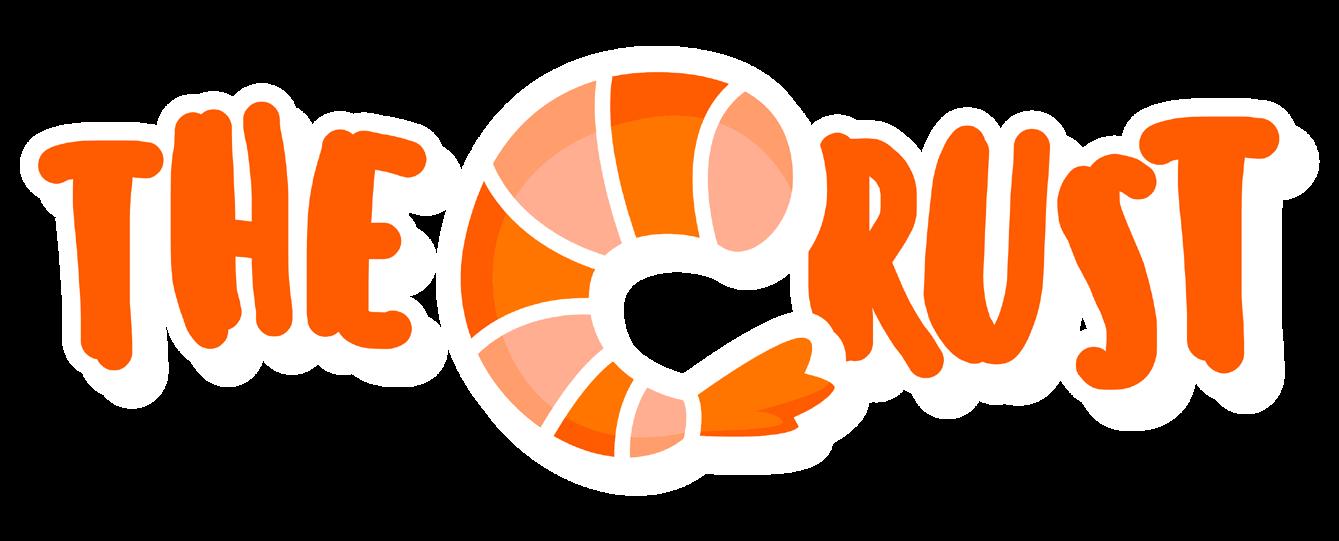
Contact Us thecrust@pmindo.com Rosebay Unit A101, Graha Famili, Blok W, Pradahkalikendal, Kec. Dukuhpakis Kota Surabaya, Jawa Timur 60227, Indonesia
Denny Leonardo
Shrimp is love
Shrimp is life

Rizky
Darmawan
The more I know, the more I realize how little I understand. So stay humble and keep on learning.
Gemilang Lim
My secret to joy in life is in finding balance. Balance in family, sweating, and making decisions.
In WeCrust Trust

























